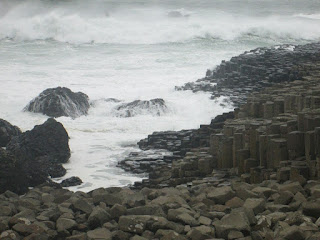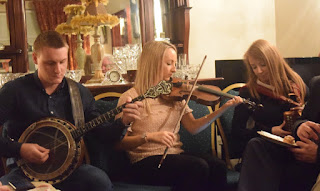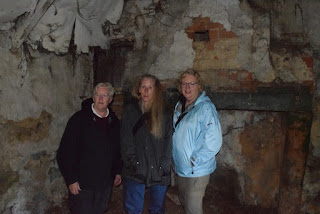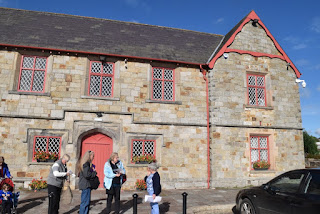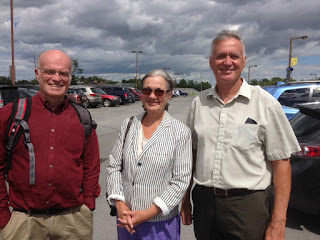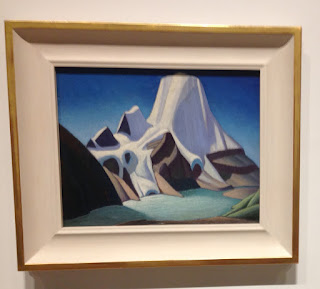On Tuesday morning, we said goodbye to
Barb and Peg, who had decided to stay behind in Mullaghbawn to
continue family research.
Richard and Sandi headed for the upper
parking lot at Slieve Gullion, put on our boots, and started the hike
up. Sandi had the idea that the trail was going to be an easy
gradual graveled path, not realizing that as we went up, it would
change to rocky and steep. Richard gave Sandi a hand at some points.
Near the top, the wind became very strong, perhaps 40 to 50 mph. Our
jackets were flapping in the wind. At the top, it was hard to stand,
and cold. Richard went to find the summit tomb. We saw the lake
near the summit, where the legend says that the giant Finn McCool was
turned into an old man. A group of three classes of elementary
school students had climbed the mountain from the East, continued
over the top, and headed down the trail that we had just gone up.
We chatted with them when they stopped to brew up a cup of tea.
After our climb, we headed north, past
Belfast, to Larne, where we stopped to buy bread and get tourist
information from a delightful young lady. We continued north of the
coast, right along the ocean. The view was fairly spectacular. We
stopped once or twice to walk on the beach, and took a detour to look
at a glen of Antrim. The glen looked somewhat different than south
Armagh, with larger fields, a bit tidier. By the time we reached
Ballycastle, Richard was exhausted. The drive had taken longer than
Google had estimated. We checked into the Marine Hotel, which had a
promotion that included 20 pounds off dinner at their restaurant.
After dinner, we crashed.
 |
Rope bridge |
Wednesday morning, we decided not to
take the ferry to Rathlin Island. We headed up the coast, which
became more spectacular, if possible. We stopped to see the rope
bridge, which was a 1 mile hike each way. We did not cross it, as
Sandi thought that it would be too scarey. We could see Scotland in
the distance.
Our next stop was at the Giant's
Causeway, which Richard had seen many years before. It was
relatively undeveloped then. It is now a UNESCO world heritage site;
there is a large modern visitor center, and a bus to take you to the
causeway. The legend says that Finn McCool built the causeway, to
challenge a Scottish giant to a fight. Geologists tell us that the
causeway is made of large crystals of basalt.
We continued to Derry, where we checked
into Caw Cottage. Jim the owner was very chatty. We walked over the
peace bridge and walked along the wall of the walled city. Richard
somehow misunderstood the directions to the restaurant, and we ended
up at the train station. When we asked a young lady where the
restaurant was, Teresa gave us a ride, as the restaurant was some
distance from the train station. Quay West (pronounced Key West) was
a modern place with good food. We chatted with the bartender at some
length; he was surprisingly knowledgeable about US college football.
He was working three jobs, as he and his wife just had a baby. We
took a taxi back to our B&B. Unfortunately, we discovered that
the bed was extremely soft. Richard could not sleep, so at midnight
we packed up quietly and left, leaving a note and some money, and
checked into the Premier Inn nearby, where we immediately fell
asleep. We got up at 9:30 AM, and had breakfast at Tesco, in the
shopping center nearby, where we bought packing tape.
We got on the road at noon on Thursday,
and arrived at Mullaghbawn as the kids were getting out from school,
in time to say goodbye to Patrick. We shipped a box of rocks back to
the states, and said goodby to Dermot and Ann. They had been
fabulous hosts for us, and continued to be great hosts for Peg and
Barb.
Peg and Barb had productive time in
Mullaghbawn, and learned a lot about the ancestors. Kevin continued
to meet with Peg and Barb, and was very generous with his time.
The drive to the Dublin Airport was
uneventful. We checked into another Premier Inn, and Richard turned
in the rental car. We had dinner there, as we needed to get up
early for the flight home. In the morning, Peggy and Barb set a record, from bed to the bus in 15 minutes, after Richard knocked on their door. The trip home was uneventful; the blog is being written from the Delta Club in Atlanta.
Richard had driven about 1100 km during
the trip, and concluded the following: Driving on the left is
mentally tiring, especially for the driver. Google is optimistic
about how long it takes to drive anywhere; figure to add 30% to their
time estimates in Ireland. Those two factors mean that the driving
distances should be reduced. Richard felt really worn down from
driving by the end of the trip.




